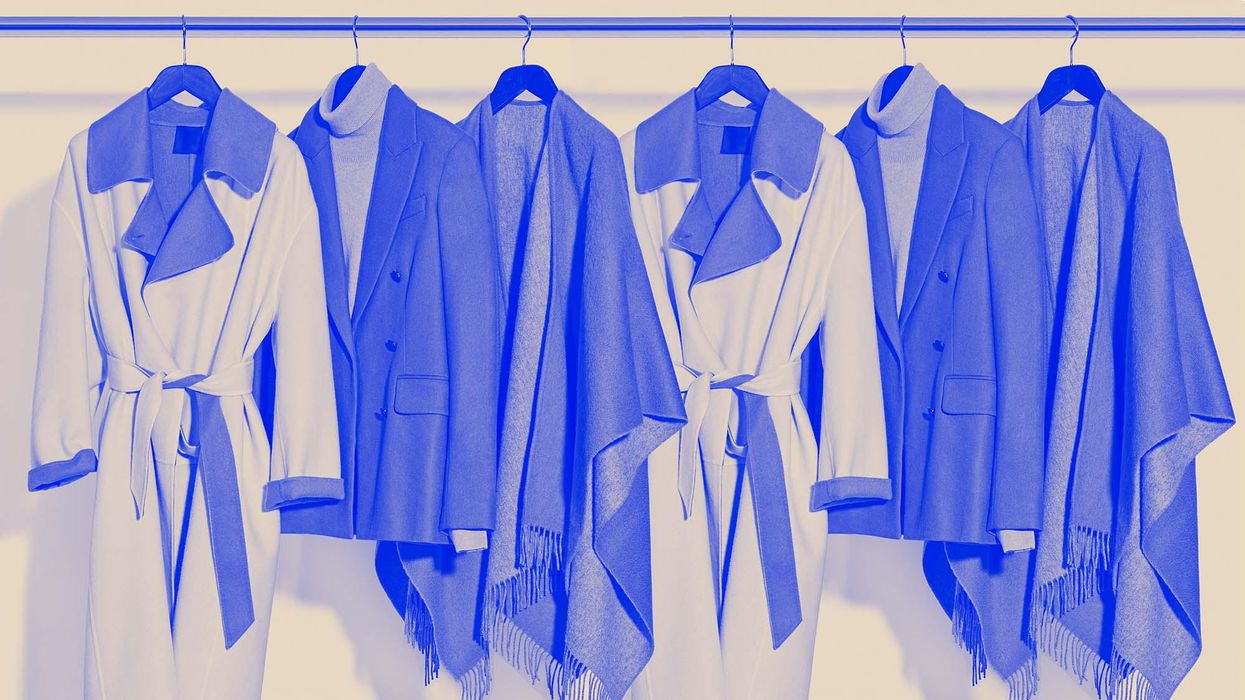Rethinking My Closet In An Unwelcome But Familiar World
Editor Alyssa Hardy shares her argument against a wardrobe refresh.

It may be a bit naive to think that today’s circumstances are the same as those early weeks of lockdown in 2020—we have more science and a vaccine for one thing—but, as I sit at my desk writing this, I know that outside, the weather in New York City is bitter cold, the COVID-19 testing lines are long, hospitals are overwhelmed, and the risks of getting sick while doing the most basic tasks are higher than ever. It’s not the same, but it certainly feels … close. A commonly felt side effect of letting those familiar feelings creep in is a propensity to turn my back on the wardrobe I recently brought back into my life, throw on sweatpants and slippers, and lock my doors until further notice.
The problem is, I don’t want to commit to that practice again. Sure, putting on soft (and often mismatched) clothing was a way to bring necessary comfort into our lives amidst a world of chaos two years ago, but now, it reminds me of a moment where I lost myself. The love I had for those pieces of fabric hanging in my closet is gone, and in its place, feelings of hopelessness persist. Perhaps a metaphor for the pandemic, the inability to dress was a tangible and unwelcomed change that left me demoralized. Ultimately, it was never about what I decided to put on; it was about what I couldn’t bring myself to wear anymore, even after it felt okay to come back to life a little bit.
Dresses felt strange with nothing to celebrate, jeans sat heavy on my skin, and the pretty tops I once threw on without a thought now looked awkward as I tried to figure out what to wear with them. Heeled ankle boots I thoughtlessly zipped up every morning before I ran to catch the subway made my feet hurt. Slippers I only wore to the shower became my go-to footwear. These realizations were debilitating for a person who built a life on loving fashion, and the urge to get rid of all it and start fresh was the only solution I could find.

Though this time around, after allowing myself to establish a new relationship with my closet, I realized that maybe I had a chance to recalibrate the way I think about it.
Before I address what changed in the last few months, I want to talk about a larger, more general shift in fashion over the previous two years. The personal crisis I described was not unique to the clothing rack collecting dust in my Queens apartment. Cleansing our closets as we change mentally, emotionally, and sometimes physically to make room for something that feels more of-the-moment was something millions of us started doing last year. In 2021, there was somewhat of a resale boom. Searches for secondhand clothing were up 80% from the previous year and according to resale site ThredUp’s annual report, the amount of new sellers on the platform has grown over 76% since 2019. That means over 30 million people started clearing out their closets in the last two years—and that number is expected to triple in the next three.
While normalizing secondhand clothing is a good development, it also indicates that our consumption habits are higher than ever. Even more so, much of the clothing that is cycled through resale sites and consignment shops is fast fashion. We are wearing items once or twice and then selling them only to buy more and repeat—a trend further supported by the fact that fast fashion has shown no signs of slowing down despite our seemingly eco-friendly awakening and parallel shift toward resale. Last year, Shein, the ultra-fast fashion brand based in China, was the most downloaded app in the United States; it beat Amazon in May. If you search the brand on any secondhand apps, you’re likely to find tens of thousands of barely worn items made and sold within just a few months. Just because we aren’t shopping new, doesn’t mean we don’t still have a huge problem with the sheer volume of clothing consumption.
With this in mind, I took a step back to think about why I constantly battle with my wardrobe. In particular, I wanted to understand why the conversation in my head went right back to its July 2020 state, even though so much has changed since those uncertain weeks. Would the uncomfortable reality that “back to normal” was a mirage built on hopeful thinking be helped by swapping a pair of jeans? Maybe for a little bit, until you want to do it again. Yes, expanding the life cycle of clothing is better than throwing it away; however, the constant need to have something new (even if it’s just new to me) is how fashion became one of the most significant contributors to worldwide waste and labor issues. I don’t want those heavy-feeling jeans to be tossed aside alongside millions of tons of other unwanted pieces, and I especially don’t want to devalue the work of the people who made them.

So I made the decision to take my clothes off my rack and out of my drawers and figure out a way to love them again. In some cases, I realized the pieces didn’t fit. My black corduroys are great but they’re too long and a little tight on the waist. Nothing that a tailor couldn’t fix, so why haven’t I brought them to one? In other cases, sweaters that are a few years old and no longer shining within the trend cycle need only a slight adjustment. Could I style one differently with a collared shirt or over a dress before I decide to cast it off? Instead of continuing this habit of consuming with every mood swing, rethinking each piece before it lands in a garbage bag is a small step toward building the elusive sustainable closet we so often hear about.
I love vintage, upcycling, and responsible manufacturing, but the only way to really guarantee that my closet is even sort of sustainable is to actually wear what’s in it, and appreciate the hours that went into creating and curating each piece. It’s more laborious—I am not suggesting that I don’t buy clothing—but I think it’s worth it to take a step back from the cycle of trends and shopping to find a little piece of the woman who lost herself in those months. Of course, individual choice will not solve the problems that overconsumption has caused but it certainly can be the catalyst we need to change the system. For me, that means giving myself space to recognize that my style is evolving as the world does and as silly as it sounds, that can be painful. Clothing is the way we tell our stories and sometimes those stories, especially this year, are unpleasant. It also means recognizing that an add to cart button won’t fix those feelings, but finding purpose in why I’m wearing what I already own might help.Illustration: Coveteur; Photo: Bonetta/Getty
Want more stories like this?
A Fashion Consumer’s Guide to the B-Corp Certification
What is Greenwashing?
3 Festive Ensembles You Can Recreate Using Things You Already Own




